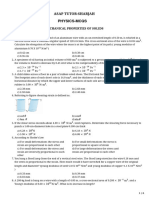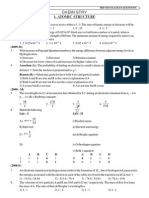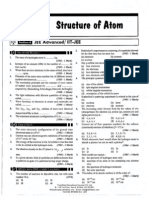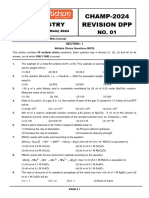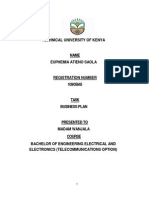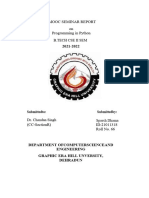0 ratings0% found this document useful (0 votes)
165 viewsStructure of Atom Questions
Structure of Atom Questions
Uploaded by
Samarth DokeThe document discusses the structure of atoms and various concepts related to atomic orbitals, electrons, and quantum numbers. It contains 25 multiple choice questions about topics like the shapes and orientations of atomic orbitals, electron configurations, quantum numbers, and principles from Bohr's theory of the atom and Heisenberg's uncertainty principle. The questions cover information about the principal quantum number, angular momentum, energy levels and subshells, and the organization of electrons in atoms and ions.
Copyright:
© All Rights Reserved
Available Formats
Download as PDF, TXT or read online from Scribd
Structure of Atom Questions
Structure of Atom Questions
Uploaded by
Samarth Doke0 ratings0% found this document useful (0 votes)
165 views2 pagesThe document discusses the structure of atoms and various concepts related to atomic orbitals, electrons, and quantum numbers. It contains 25 multiple choice questions about topics like the shapes and orientations of atomic orbitals, electron configurations, quantum numbers, and principles from Bohr's theory of the atom and Heisenberg's uncertainty principle. The questions cover information about the principal quantum number, angular momentum, energy levels and subshells, and the organization of electrons in atoms and ions.
Original Title
Structure of atom questions
Copyright
© © All Rights Reserved
Available Formats
PDF, TXT or read online from Scribd
Share this document
Did you find this document useful?
Is this content inappropriate?
The document discusses the structure of atoms and various concepts related to atomic orbitals, electrons, and quantum numbers. It contains 25 multiple choice questions about topics like the shapes and orientations of atomic orbitals, electron configurations, quantum numbers, and principles from Bohr's theory of the atom and Heisenberg's uncertainty principle. The questions cover information about the principal quantum number, angular momentum, energy levels and subshells, and the organization of electrons in atoms and ions.
Copyright:
© All Rights Reserved
Available Formats
Download as PDF, TXT or read online from Scribd
Download as pdf or txt
0 ratings0% found this document useful (0 votes)
165 views2 pagesStructure of Atom Questions
Structure of Atom Questions
Uploaded by
Samarth DokeThe document discusses the structure of atoms and various concepts related to atomic orbitals, electrons, and quantum numbers. It contains 25 multiple choice questions about topics like the shapes and orientations of atomic orbitals, electron configurations, quantum numbers, and principles from Bohr's theory of the atom and Heisenberg's uncertainty principle. The questions cover information about the principal quantum number, angular momentum, energy levels and subshells, and the organization of electrons in atoms and ions.
Copyright:
© All Rights Reserved
Available Formats
Download as PDF, TXT or read online from Scribd
Download as pdf or txt
You are on page 1of 2
Structure of atom
1) The orbital which has n directional character is
a) s b) d c) p d) f
2) The two lobes of a p-orbital are separated by
a) a nodal plane b) a plane of zero electron density
b) both of these c) none of these
3) Among the following subshells, the lowest energy is of
a) 4f b) 6s c) 6p d)5d
4) The number of subshells present in a main energy shell is equal to
a) (n+l) b) l c) (n – l) d) n
5) The total number of unpaired electrons present in P atom (At. No. 15) is /are
a) 0 b) 1 c) 3 d) 2
6) An atom contains 17 electrons and 20 neurons. Its mass number is
a) 37 b) 17 c) 20 d) none of these
7) Which one of the following sets of quantum numbers is possible?
a) n = 2, l = 2, m =+1, s = -1/2 b) n = 3, l = 2, m = -2, s = +1/2
c) n = 1, l = 1, m =0, s = -1/2 d) n = 3, l = 3, m =0, s = -1/2
8) If n = 3, the total values of “m” are
a) 4 b) 9 c) 6 d) 5
9) For which one of the following species, Bohr’s theory is not applicable?
a) Li+ b) He+ c) Be3+ d) H
10) Jump of an electron from M-shell to L-shell gives rise to
a) an emission spectrum b) an absorption spectrum
c) visible spectrum d) UV spectrum
11) The number of unpaired electrons in Cu+ is/are
a) 1 b) 2 c) 0 d) 3
12) The orbital(s) lying in xy plane is
a) dxy b) dyz c) dx2 – y2 d) both a & c
13) The angular momentum of an electron in L-shell is equal to
a) b) c) d)
13) The principal quantum number gives information about
a) size of the orbit b) energy of electron c) angular momentum of electron
d) all these
14) After filling 4d subshell the electron will enter
a) 5s d) 3d c) 4p d) 5p
15) The correct electronic configuration of a cuprous ion is
a) [Ar] 3d94s1 b) [Ar] 3d10 c) [Ne] 3d94s1 d) none of these
16) Heisenberg’s uncertainty principle is not valid or a
a) moving electron b) moving photon c) stationary particle d) moving proton
17) The wave nature of electron was verified by
a) de Broglie b) Davisson and Germer c) Thomson d) Planck
18) The number of s and p-electrons are equal in case of
a) F d) Na d) C d) Mg
19) The total spin in a Co+2 ion (At. No. 27) is
a) b) c) d)
20) The lase electron in an atom has quantum numbers n=3, l=0, m=0. The atom is
a) Li d) Cl c) K d) Na
21) Among the following, the electron most tightly held by the nucleus, belongs to
a) 4s b) 3d c) 3p d) 4p
22) 18 electrons are present in the outermost orbit of
a) Cu2+ b) Cu+ c) Zn d) Ni
23) The de Broglie’s equation suggests that an electron has
a) particle nature b) wave nature c) both these d) none of these
24) The total number of atomic orbitals in fourth energy level of an atom is
a) 4 b) 8 c) 16 d) 32
25) Anomalous behavior of Cr and Cu is due to
a) extra stability of d orbitals b) extra stability of p orbitals
c) both (a) and (b) d) none of these
You might also like
- Asap-Mechanical Properties of Solids-McqsDocument6 pagesAsap-Mechanical Properties of Solids-McqsjimmyemandeeNo ratings yet
- Oracle Database Administration IDocument46 pagesOracle Database Administration Iocp001No ratings yet
- Cor Vision PlusDocument224 pagesCor Vision PlusAndrei Ivanov67% (3)
- Capital Med in BriefDocument4 pagesCapital Med in BriefE BNo ratings yet
- PMR Spectroscopy: Solved Problems Volume : IIFrom EverandPMR Spectroscopy: Solved Problems Volume : IIRating: 5 out of 5 stars5/5 (3)
- DragonDocument10 pagesDragonCristina Amariutei100% (7)
- MCQ Structure of AtomDocument15 pagesMCQ Structure of AtomSasuke Itachi100% (1)
- SOME BASIC AssignmentDocument2 pagesSOME BASIC Assignmentmujeebc 1972No ratings yet
- Amines NEET QuestionDocument13 pagesAmines NEET Questionmahi.nitukNo ratings yet
- Inorganic Race - (NEET) - NurtureDocument10 pagesInorganic Race - (NEET) - NurtureKAVYA CHANDORENo ratings yet
- DPP (31 To) IcDocument41 pagesDPP (31 To) IcRaju SinghNo ratings yet
- XI JEE Chemistry Pracice Sheet 02Document298 pagesXI JEE Chemistry Pracice Sheet 02ak1740120No ratings yet
- Redox Reactions & ElectrochemistyDocument24 pagesRedox Reactions & ElectrochemistyDeep Chavan100% (1)
- Atomic Structure DPP 03amit Sir Atomic Structure DPP 03amit SirDocument3 pagesAtomic Structure DPP 03amit Sir Atomic Structure DPP 03amit Sirl kaneNo ratings yet
- Structure of Atom - High Yield MCQs For NEET 2023Document5 pagesStructure of Atom - High Yield MCQs For NEET 2023Maitri RoyNo ratings yet
- Sicmyb - DPP Mole ConceptDocument6 pagesSicmyb - DPP Mole ConceptBorn to fightNo ratings yet
- The D and F-Block Elements: SolutionsDocument20 pagesThe D and F-Block Elements: SolutionsAnil AggaarwalNo ratings yet
- CLS Aipmt 17 18 XIII Che Study Package 4 SET 1 Chapter 16Document45 pagesCLS Aipmt 17 18 XIII Che Study Package 4 SET 1 Chapter 16Ayush Kumar100% (1)
- Important Questions For CBSE Class 11 Chemistry Chapter 4Document15 pagesImportant Questions For CBSE Class 11 Chemistry Chapter 4PriyanshuNo ratings yet
- NEET UG Chemistry Solutions PDFDocument31 pagesNEET UG Chemistry Solutions PDFAlexa Siddhi0% (1)
- Structure of Atoms JEE NEET Sameer SirDocument34 pagesStructure of Atoms JEE NEET Sameer Sirsameer devidasNo ratings yet
- System of Particles & Rotational Motion: SolutionsDocument50 pagesSystem of Particles & Rotational Motion: SolutionsKrishna Bhadra100% (1)
- Assignment 1 AtomicDocument7 pagesAssignment 1 AtomicAman9692No ratings yet
- Jitendra Hirwani: Problem Solving Techniques of Physical Chemistry For NeetDocument18 pagesJitendra Hirwani: Problem Solving Techniques of Physical Chemistry For NeetabhishekNo ratings yet
- P-Block (Group 13 To 14) NM Solution (-1) Chem PDFDocument31 pagesP-Block (Group 13 To 14) NM Solution (-1) Chem PDFChauhan RonakNo ratings yet
- DPP#21-22 PERIODIC TABLE Prev. YrDocument4 pagesDPP#21-22 PERIODIC TABLE Prev. YrLakshya ChandakNo ratings yet
- Class 9 Chemistry Chapter Structure of Atoms McqsDocument17 pagesClass 9 Chemistry Chapter Structure of Atoms McqsAltaf hussainNo ratings yet
- (87 - 114) 2B. Structure of Atoms (OBJ)Document28 pages(87 - 114) 2B. Structure of Atoms (OBJ)Mayuri chatpalliwarNo ratings yet
- 11 Chemistry Impq Ch02 Structure of Atom KvsDocument11 pages11 Chemistry Impq Ch02 Structure of Atom KvsshubhammukriNo ratings yet
- Atomic Structure: Chemistry DPP 5 by Garima Verma (Chemistry Faculty) - Referral Code: "Cgvmam"Document2 pagesAtomic Structure: Chemistry DPP 5 by Garima Verma (Chemistry Faculty) - Referral Code: "Cgvmam"Tanisha SubudhiNo ratings yet
- Neet DPPDocument19 pagesNeet DPPxyzNo ratings yet
- AToms Model Questions + SolutionDocument8 pagesAToms Model Questions + SolutionKarttik SinghNo ratings yet
- Haloalkanes and Haloarenes: Chemistry DPP 1 by Garima Verma (Chemistry Faculty) - Referral Code: "Cgvmam"Document4 pagesHaloalkanes and Haloarenes: Chemistry DPP 1 by Garima Verma (Chemistry Faculty) - Referral Code: "Cgvmam"Tanisha SubudhiNo ratings yet
- DPP 01 Chemical Bonding MridulPandey MergedDocument4 pagesDPP 01 Chemical Bonding MridulPandey Mergedsaurabh shaurya guptaNo ratings yet
- Final 01 A Some Basic Concept of Chemistry PDFDocument22 pagesFinal 01 A Some Basic Concept of Chemistry PDFSwastik TripathiNo ratings yet
- GR-XII Neet WORKSHEET - PHYSICS (Wave Optics)Document3 pagesGR-XII Neet WORKSHEET - PHYSICS (Wave Optics)Rahul RahulNo ratings yet
- Chemistry Question Bank For JEE Advance Part 1Document55 pagesChemistry Question Bank For JEE Advance Part 1gfffdssseNo ratings yet
- Structure of Atom QuestionsDocument5 pagesStructure of Atom QuestionssingamroopaNo ratings yet
- Che Nomenclature MCQDocument28 pagesChe Nomenclature MCQParth PatelNo ratings yet
- Atomic Structure: ChemistryDocument8 pagesAtomic Structure: ChemistryGowtham BurleNo ratings yet
- Chemical Kinetic PDFDocument44 pagesChemical Kinetic PDFAmogh VaishnavNo ratings yet
- Atomic Structure IITDocument16 pagesAtomic Structure IITAdiChemAdi69% (13)
- Aakash Model Test Papers Solutions XI ChemistryDocument30 pagesAakash Model Test Papers Solutions XI Chemistrykedar_kholiya99100% (1)
- Periodic Classification of ElementsDocument8 pagesPeriodic Classification of ElementsNighin NazerNo ratings yet
- DPP 3 PhysicsDocument2 pagesDPP 3 PhysicsSanjay VermaNo ratings yet
- Chemical Bonding and Molecular StructureDocument10 pagesChemical Bonding and Molecular StructureGagan NdNo ratings yet
- Chemistry: DPP - Daily Practice ProblemsDocument7 pagesChemistry: DPP - Daily Practice ProblemsAdityaNo ratings yet
- Kinematics - NEETDocument25 pagesKinematics - NEETAlok SinghNo ratings yet
- Structure of AtomDocument7 pagesStructure of AtomShardaVermaNo ratings yet
- DPP-1 - PC Copy (Equivalent Concept, Mole Concept)Document3 pagesDPP-1 - PC Copy (Equivalent Concept, Mole Concept)prashantyadavpky07No ratings yet
- Solved Examples: Acc-Ch-Mole ConceptDocument11 pagesSolved Examples: Acc-Ch-Mole ConceptTushar SinghNo ratings yet
- Chemistry PYQ UnlockedDocument5 pagesChemistry PYQ UnlockedSumit ChauhanNo ratings yet
- NTA NEET MAIN 101 Speed Tests-150-153Document4 pagesNTA NEET MAIN 101 Speed Tests-150-153Palmurugan MNo ratings yet
- YesDocument38 pagesYesRashmi GuptaNo ratings yet
- Chemical Bonding and Molecular StructureDocument30 pagesChemical Bonding and Molecular StructureXenon ClassesNo ratings yet
- Chemical Bonding KRR PDFDocument40 pagesChemical Bonding KRR PDFggk201367% (3)
- Amines PDFDocument34 pagesAmines PDFRam KhannaNo ratings yet
- MCQ On Periodic Classification of ElementsDocument2 pagesMCQ On Periodic Classification of ElementsNanda Rani SenNo ratings yet
- DPP - 01 - Reaction MechanismDocument5 pagesDPP - 01 - Reaction Mechanismbaibhav singhNo ratings yet
- Assignment Periodic Table JH Sir-3575Document30 pagesAssignment Periodic Table JH Sir-3575aachu100% (1)
- Xii - Neet Exam 3 - 27-11-2017Document17 pagesXii - Neet Exam 3 - 27-11-2017pullaiNo ratings yet
- Assignment No 8Document2 pagesAssignment No 8kanwaljitbabyNo ratings yet
- C3 Home AssignmentDocument2 pagesC3 Home AssignmentMemoona GullNo ratings yet
- Atomic Structure ReviewDocument7 pagesAtomic Structure ReviewKinal PatelNo ratings yet
- Notion SQL CodeDocument4 pagesNotion SQL CodephurinthammarowetNo ratings yet
- Sap HanaDocument245 pagesSap HanaANNAMALAI VELMURUGANNo ratings yet
- Comprehensiveproblemset#8Document15 pagesComprehensiveproblemset#8DEO100% (1)
- Concentration of SolutionsDocument4 pagesConcentration of SolutionsPRANAV BANSAL100% (1)
- Pass Leader DumpsDocument30 pagesPass Leader DumpsHyder BasetNo ratings yet
- Conjug4 Conjugacoes PortugueseDocument5 pagesConjug4 Conjugacoes PortugueseKareyNo ratings yet
- PresentationsDocument1 pagePresentationsMadina SaparbaevaNo ratings yet
- Principal Intuitionistic Fuzzy Ideals and Filters On A LatticeDocument14 pagesPrincipal Intuitionistic Fuzzy Ideals and Filters On A LatticeDalia MuraddNo ratings yet
- MATH 8 Lesson Plan CODocument3 pagesMATH 8 Lesson Plan COSerdnelem Rhodz MacedaNo ratings yet
- SAP Netweaver GatewayDocument16 pagesSAP Netweaver GatewayVictor UribeNo ratings yet
- Ielts Speaking Part 2 Questions and Answers PDF 40 d33486f7b9Document3 pagesIelts Speaking Part 2 Questions and Answers PDF 40 d33486f7b9Asad MiltonNo ratings yet
- Business PlanDocument36 pagesBusiness PlanArun NarayananNo ratings yet
- PPTDocument38 pagesPPTLouis rajNo ratings yet
- Ste Micro ProjectDocument13 pagesSte Micro Projectethicalninja7No ratings yet
- 1102 HomoeopathyDocument46 pages1102 Homoeopathysol43412No ratings yet
- Technical and Operating Instructions Manual Along With Cpl/PilDocument13 pagesTechnical and Operating Instructions Manual Along With Cpl/PilCidhin NairNo ratings yet
- KatarakDocument30 pagesKatarakdokter mudaNo ratings yet
- Daycounter Inc - Snubber Circuit Design CalculatorsDocument5 pagesDaycounter Inc - Snubber Circuit Design CalculatorsLaercio Marques100% (1)
- Gait TrainingDocument46 pagesGait TrainingCulan CuLinNo ratings yet
- Eapp Q2 W3Document46 pagesEapp Q2 W3not deniseNo ratings yet
- Mooc ReportDocument16 pagesMooc ReportSparsh DhamaNo ratings yet
- Wooden Mallet Plans - WoodArchivistDocument4 pagesWooden Mallet Plans - WoodArchivistErics100% (1)
- Australia and New ZealandDocument6 pagesAustralia and New Zealandbrunocz2No ratings yet
- A Prototype of An Orange Picking Robot: Past History, The New Robot and Experimental ResultsDocument11 pagesA Prototype of An Orange Picking Robot: Past History, The New Robot and Experimental ResultsAnaNo ratings yet
- Service Manual: Dishdrawer™ DishwasherDocument55 pagesService Manual: Dishdrawer™ DishwashermosheNo ratings yet
- Chapter-6Document29 pagesChapter-6mahletNo ratings yet
